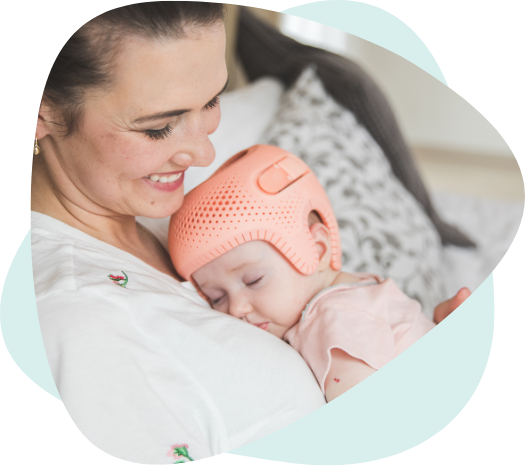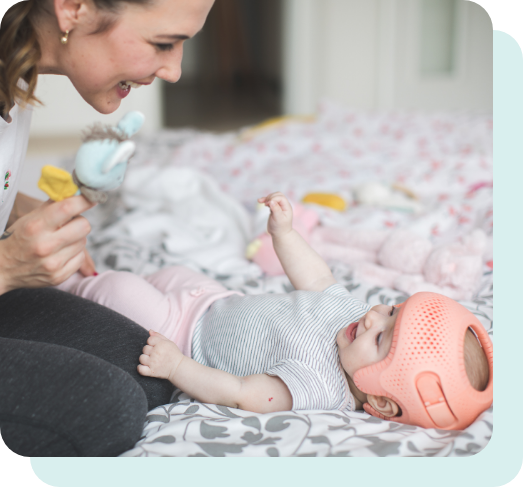Repositioning and Tummy Time
- Home >
- Community And Resources >
- Repositioning
If your baby has been diagnosed with flat head syndrome or positional plagiocephaly, repositioning can be a helpful first step to treat the condition. Repositioning is simply changing the position of your baby's head during sleep, playtime, and other activities to relieve pressure on the flat spot and promote more rounded head shape development.
In additional, tummy time is an important activity for babies during waking hours, especially those with flat head syndrome. Tummy time is when a baby is placed on their stomach to play and engage with their environment. It helps them develop their head and shoulder muscles and reduces pressure on a single spot on their head.
Here are some tips and information about repositioning and tummy time for parents:

Overview of Positioning Options
- During Sleep: Place your baby on their back to sleep, but alternate the direction that their head faces each night. You can also use a wedge or rolled-up towel to slightly elevate the head to encourage more movement.
- During Playtime: Change the position of toys, mirrors, and other stimulating objects to encourage your baby to look in different directions. You can also use a boppy pillow or other support to prop your baby up in a different position for short periods.
- During Feeding: Switch the side that you hold your baby on for feeding, as this can encourage them to look in different directions.
- During Travelling: If you use a car seat or stroller, make sure to switch the direction that your baby faces each time.

Overview of Tummy Time
- Tummy time is when your baby is placed on their stomach while awake and supervised.
- Tummy time helps develop muscles in the neck, shoulders, and upper body, which can improve head control, and reduce the risk of flat head syndrome.
- Babies can start doing tummy time as early as possible, even during the first few days of life.
- Aim for at least 3-5 minutes of tummy time, 2-3 times a day. Gradually increase the time as your baby gets stronger and more comfortable.
- It's important to start with short periods of tummy time and gradually increase the duration. Aim for 20-30 minutes total each day.
Benefits of Repositioning and Tummy Time
Repositioning and tummy time can be effective ways to prevent flat head syndrome from worsening and may even improve the condition in mild cases.
By consistently changing the position of your baby's head and encouraging them to spend time on their tummy, you can relieve pressure on the flat spot and encourage more symmetrical growth of the skull.
Both repositioning and tummy time are non-invasive and low-risk treatment options that can be done at home with no special equipment or training.

Recommended Treatment
If repositioning and tummy time are not effective or if your baby has a moderate to severe case of flat head syndrome, a cranial remoulding helmet may be recommended. This helmet is designed to gently reshape the baby's skull by applying pressure to certain areas and allowing growth in others. It is usually worn for 23 hours a day for several months, depending on the severity of the condition.
If you have concerns about your baby's head shape, don't hesitate to speak with one of our specialists. With early intervention and a tailored treatment plan, you can help ensure that your baby's head develops properly and that they achieve their full potential.

Benefits of Helmets
Cranial remoulding helmets have been shown to be highly effective in treating flat head syndrome. They are especially helpful for more severe cases where repositioning alone is not enough. The helmet works by applying pressure to the flat spot and redirecting growth to other areas of the skull, resulting in a more rounded head shape. Helmets are also non-invasive and have a high success rate with minimal side effects.
When is a Helmet Not Recommended?
While helmets are generally safe and effective, there are certain situations where they may not be recommended.
For example, if your baby is under 3 months old, has an underlying medical condition, or has already reached a certain age where the skull is no longer malleable, a helmet may not be effective. Additionally, if your baby has open sores or skin irritation on their head, a helmet may exacerbate the condition. It is important to consult with a specialist to determine if a helmet is the right treatment option for your baby.
If you are still concerned and would like some advice from our specialists, please get in touch.